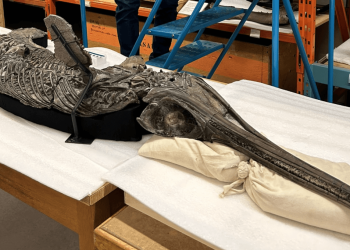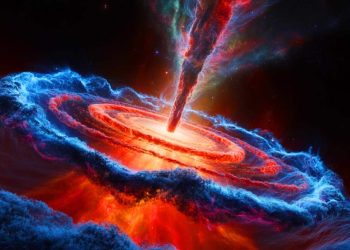| IN A WORD |
|
The discovery of a rogue planet consuming matter at an unprecedented rate has stunned astronomers and challenged our understanding of planetary formation. Cha 1107-7626, a starless rogue planet, devours gas and dust at a rate of six billion tons per second. This astonishing growth rate, observed by the European Southern Observatory’s Very Large Telescope, has sparked discussions about how planets form and evolve, particularly those that drift alone in the cosmos. The results suggest that some of these solitary worlds could form in ways similar to stars, blurring the lines between celestial categories.
The remarkable growth of a rogue planet
Rogue planets, unlike their star-orbiting counterparts, roam space untethered. Cha 1107-7626, located about 620 light years away in the constellation Chameleon, illustrates the intriguing nature of these celestial bodies. This planet, with a mass between five and ten times that of Jupiter, is currently in a phase of rapid growth. Surrounded by a disk of gas and dust, it undergoes a process called accretion, during which it draws in material from its surroundings.
Recent observations have revealed that this accretion is not a slow and steady process but rather a series of spectacular surges. By August 2025, the accretion rate had increased significantly, reaching a staggering six billion tonnes per second. Such a rapid growth rate is unprecedented on any planet, providing new insights into the mechanisms behind the formation of rogue planets. This discovery, facilitated by advanced spectrographic technology, highlights the dynamic and sometimes volatile life of planets that do not orbit stars.
‘I thought it was a problem’: NASA confirms that a mysterious sphere is escaping from the Milky Way at 1 million kilometers per hour (and no one knows why)
Chameleon Constellation Overview
The presence of Cha 1107-7626 in the constellation Chameleon has provided astronomers with a unique opportunity to study the characteristics of rogue planets. The mass of this rogue planet and its isolation make it a fascinating subject for understanding planetary evolution. The planet’s rapid accretion of gas and dust suggests its formation may share similarities with that of stars, which also undergo bursts of accretion during their early stages.
The research team, led by Víctor Almendros-Abad, used data from several sources, including the James Webb Space Telescope and ESO’s VLT, to analyze changes within the accretion disk. The increased accretion rate and subsequent chemical changes observed during this period reflect complex interactions that are more often associated with star formation. This could indicate that rogue planets like Cha 1107-7626 could form through processes traditionally thought to apply only to stars.
“Black holes regulate galaxies”: Frontier supercomputer simulation exposes fiery jets and filaments reaching 180 million °F across cosmic clusters
Blurring the lines between stars and planets
The discovery of rapid accretion in Cha 1107-7626 raises questions about the fundamental differences between stars and planets. Traditionally, stars and planets have been classified based on their formation processes and physical characteristics. However, the behavior of this rogue planet calls these distinctions into question. The presence of strong magnetic fields channeling matter toward the planet is a phenomenon previously observed only in stars.
As co-author Aleks Scholz notes, the results suggest that rogue planets could form through mechanisms similar to those of stars. This notion blurs the once clear line separating stars from planets. The study also found that the chemical composition of the accretion disk changed during the breakup, with water vapor appearing during the event. Such chemical shifts have already been documented in stellar environments, supporting the idea that planetary and star formation processes may overlap.
‘A sunless world shocks scientists’: Webb telescope discovers brown dwarf with blazing auroras and a magnetic field stronger than Earth’s
The Future of Research on Rogue Planet
As technology advances, the study of rogue planets like Cha 1107-7626 is about to enter a new era. The European Southern Observatory’s upcoming Extremely Large Telescope (ELT) promises to improve our ability to detect and analyze these elusive celestial bodies. With its powerful instruments, the ELT will allow astronomers to explore the characteristics of rogue planets in more detail, and potentially discover more about their formation and evolution.
As astronomer Amelia Bayo points out, the prospect of studying planetary objects exhibiting star-like behavior is both exciting and challenging. Understanding the early stages of rogue planets could provide valuable insights into the diversity of planetary systems and the processes that govern their formation. The knowledge gained from these studies could reshape our understanding of the cosmos and the different ways in which celestial bodies come into existence.
The discovery of the rapid growth of Cha 1107-7626 offers insight into the complex and fascinating world of rogue planets. These findings invite further exploration of their formation and potential overlap with stellar processes. As we continue to uncover the mysteries of these cosmic wanderers, what new information about planetary and stellar evolution might we discover?
This article is based on verified sources and supported by editorial technologies.
Did you enjoy it? 4.6/5 (28)









